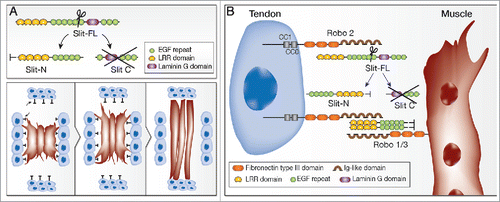Figures & data
Figure 1. Slit cleavage directs muscle elongation A. upper panel shows the details of Slit cleavage into Slit-Nterminal (Slit-N) and Slit C-terminal (Slit C). The lower panels describe consecutive stages in the elongation of the 3 lateral transvers muscles deduced form the live imaging of these muscles: whereas the leading edges of these muscles are always at their dorsal or ventral edges, lateral filopodia are inhibited by the tendon cells at the segmental borders, leading to net extension in dorsal-ventral direction. When the leading edges are heading the cluster of tendons located in the middle of the segment their elongation is arrested. B. Robo2 binds to Slit in “cis” at the surfaces of the tendon cells. This facilitates Slit cleavage and the formation of Slit-N oligomers, which then associate with the tendon cell membrane possibly by binding to Robo2 and other receptors. Slit-N oligomers signal to the muscle through Robo (Robo+Robo3) receptors at the muscle side and induce repulsion or stop signal.

